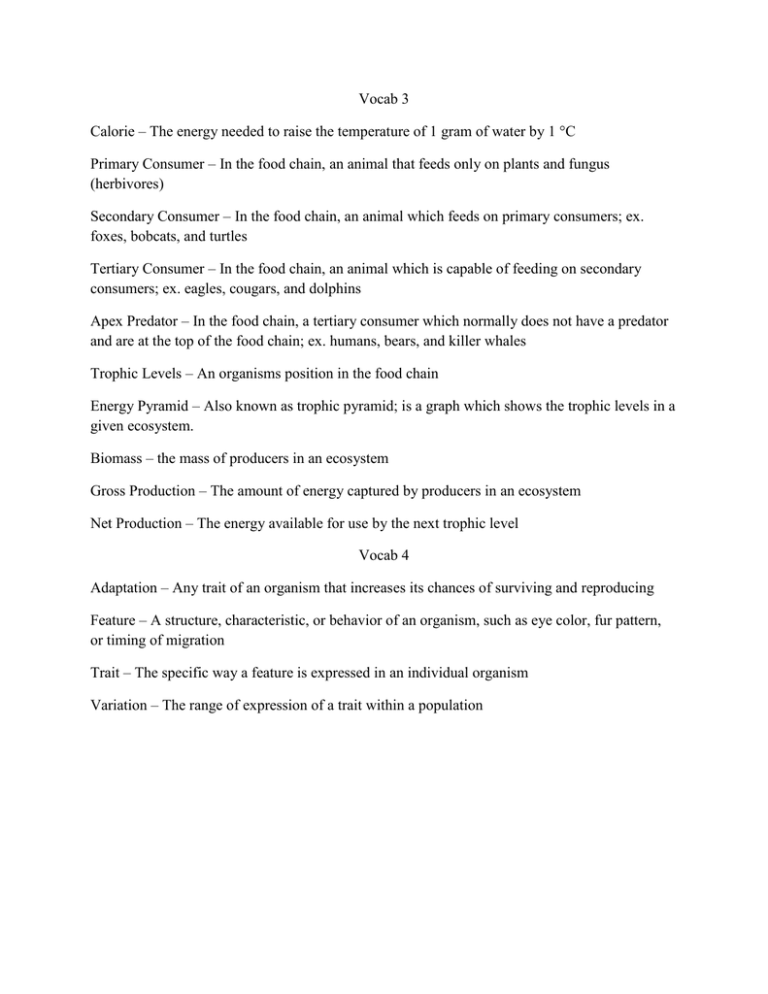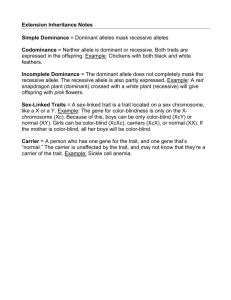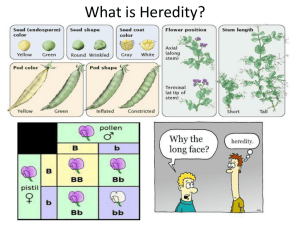File vocab 3
advertisement

Vocab 3 Calorie – The energy needed to raise the temperature of 1 gram of water by 1 °C Primary Consumer – In the food chain, an animal that feeds only on plants and fungus (herbivores) Secondary Consumer – In the food chain, an animal which feeds on primary consumers; ex. foxes, bobcats, and turtles Tertiary Consumer – In the food chain, an animal which is capable of feeding on secondary consumers; ex. eagles, cougars, and dolphins Apex Predator – In the food chain, a tertiary consumer which normally does not have a predator and are at the top of the food chain; ex. humans, bears, and killer whales Trophic Levels – An organisms position in the food chain Energy Pyramid – Also known as trophic pyramid; is a graph which shows the trophic levels in a given ecosystem. Biomass – the mass of producers in an ecosystem Gross Production – The amount of energy captured by producers in an ecosystem Net Production – The energy available for use by the next trophic level Vocab 4 Adaptation – Any trait of an organism that increases its chances of surviving and reproducing Feature – A structure, characteristic, or behavior of an organism, such as eye color, fur pattern, or timing of migration Trait – The specific way a feature is expressed in an individual organism Variation – The range of expression of a trait within a population Vocab 5 Nucleus – A cell organelle which regulates the functions of the cell and contains all of the genetic material (DNA) of the cell. (Note: Sort of like the brain of the cell) Chromosome – A structure that transfers heredity information to the next generation Gene – The basic unit of heredity carried by the chromosomes; code for features of organisms DNA – Short for, Deoxyribonucleic acid, DNA is present in nearly all living organisms. Chromosomes are made up of DNA. DNA is a carrier of genetic information. Allele – Variations of genes that determine traits in organisms; the two corresponding alleles on two paired chromosomes constitute a gene Phenotype – The physical traits produced by the genotype; the physical expression of the genes Genotype – An organism’s particular combination of paired alleles Dominant Allele – A form of a gene that is expressed as the trait when a dominant allele is present Recessive Allele – A form of a gene that is expressed as the trait only when a dominant allele is not present Homozygous Gene – A gene composed of two identical alleles (either both dominant or both recessive) Heterozygous Gene – A gene composed of two different alleles (a dominant and a recessive) Vocab 6 Natural Selection – The process by which the individuals best adapted to their environment tend to survive and pass their traits to subsequent generations Artificial Selection – The process by which humans manipulate the breeding process of animals in order to create an individual with desired traits









